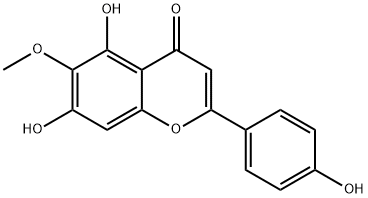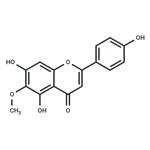Uses
Hispidulin has been used as a calibration standard:
- in high-performance liquid chromatography (HPLC) for quantification of Clerodendrum petasites flavonoids
- in liquid chromatography/electrospray ionization mass spectrometry (LC/ESI-MS) analysis
- in reverse-phase high-performance liquid chromatography with a diode-array detector (HPLC-DAD) and high-performance thin-layer chromatography (HPTLC)
Definition
ChEBI: A monomethoxyflavone that is scutellarein methylated at position 6.
General Description
This substance is a primary reference substance with assigned absolute purity (considering chromatographic purity, water, residual solvents, inorganic impurities). The exact value can be found on the certificate. Produced by PhytoLab GmbH & Co. KG
Biological Activity
Partial positive allosteric modulator at the benzodiazepine receptor (IC 50 = 1.3 μ M for inhibition of flumazenil binding); natural sage flavone. Stimulates GABA-induced chloride currents in Xenopus oocytes expressing α 1 α 2-, α 3-, α 5- or α 6- β 2 γ 2S GABA A receptors. Brain penetrant; oral administration reduces seizures in a gerbil model of epilepsy. Also has antifungal, antiproliferative, antioxidant and antithrombotic properties.
Biochem/physiol Actions
Hispidulin is a bioactive flavonoid with a variety of effects including antiproliferative, antifungal, anti-inflammatory, antioxidative and antiepileptic activity. Like EGCG, hispidulin appears to activate AMPK and inhibit the PI3K/Akt/mTOR pathway. The antiepileptic activity may be due to additional activity as a benzodiazepine (BZD) receptor ligand.




